How to care for houseplants in winter: 5 tips to keep your indoor garden healthy
Our expert advice on how to care for houseplants in winter includes where to put them and how often to water
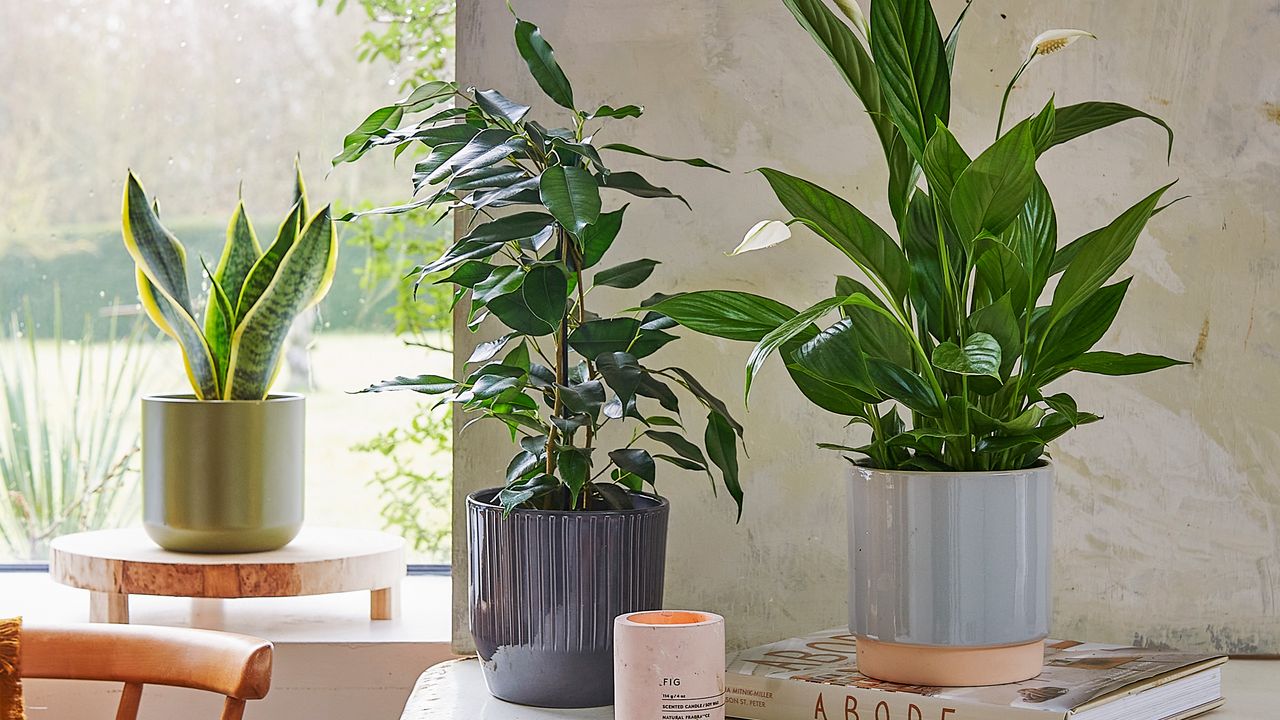

You'll need to know how to care for houseplants in winter whether you're the owner of just a few pots or an entire indoor garden. They may be slowing down their growth during the colder months, but they still need some TLC to ensure they stay healthy.
Sure, there are plenty of gorgeous winter garden ideas to recreate outdoors. But, adding greenery to your interior means you can enjoy all the benefits from the warmth of your own home. And it's not just about all the Instagram-worthy shelfies you can take – research suggests that houseplants can do wonders for our mental and physical wellbeing. The sight of green growth and the sensory pleasure of touching the leaves, especially on textured plants such as ferns, is a real mood booster and reduces stress. And they are also known to help clean the air by removing carbon dioxide and toxic particles.
So far, so good. But at this time of year, it's crucial to know how to care for indoor plants in winter properly, so that you can keep them thriving. Luckily, we've got all the tips you need.
Expert tips on how to care for houseplants in winter
From how often to water to the best place to put them, our advice will keep your best indoor plants looking as good as possible this season.
1. Deadhead indoor plants regularly
Some of the easiest indoor plants to grow are spider plants, weeping figs, ornamental ivies, Boston fern, mother-in-law's tongue, peace lily, and money tree. Pile them high: you can never have enough houseplants for your indoor garden ideas – and now's the time to go big indoors when there's not much action in the garden.
Keep on the case with them, though. Treat yourself to a pair of the best secateurs and cut off any brown leaves and deadhead regularly (especially new, flowering plants). Not only will this make their appearance look smarter, but it will also help to ward off diseases and keep them healthy.
And speaking of keeping them healthy, remember to keep an eye out for pests, which love snug, centrally-heated houses. Check leaves over every week or so and either wipe the leaves clean if you spot anything, or use an organic spray. You can find out how to get rid of thrips – a common houseplant intruder – in our guide.
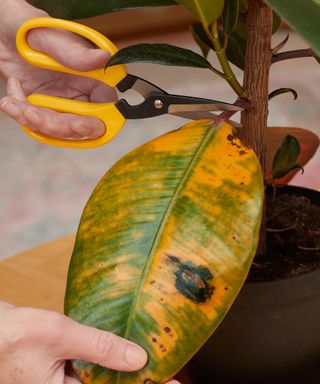
Remove decaying leaves
2. Provide plenty of natural light
'The afternoon darkness is something we all dislike about winter,' says Jo Lambell, founder of Beards & Daisies – your houseplants included. As the days get shorter, move your indoor plants to where they can make the most of available natural light. Most prefer it to be bright yet indirect.
Wiping leaves with a soft, damp cloth also removes dust and dirt, helping them maximize daylight.
'You may find your plants need additional sources of light in order to thrive,' Jo adds. 'Consider adding an LED growing light for a more concentrated hit.'
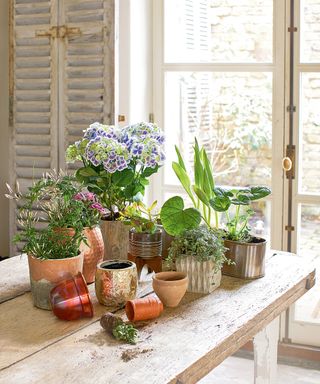
Most houseplants prefer bright, indirect light
3. Keep the temperature steady
'To crank up the central heating or not? This is always a divisive subject in households and offices alike – and also a point of contention for plants, too,' says Jo Lambell.
'Both central heating vents and radiators generate dry air which can upset tropical plants which thrive in humid conditions. Make sure your plants are not positioned nearby them and consider additional ways of topping up their humidity needs,' (see below).
They don't like to get too cold, either. Putting your plants along a windowsill may seem a logical solution to meeting their needs for natural light, but it can get too cold for them overnight. This is especially the case if they're stuck behind closed curtains, as cold air will be trapped there, which does them no good. To get around this, simply move them each evening and put them back the next morning.
Overall, they will be happiest somewhere with a steady temperature, away from sources of direct heat and draughts.
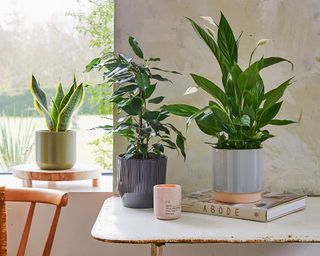
Avoid keeping your plants too close to heat sources
4. Up the humidity
One of the best and easiest ways to increase the humidity for your plants is by misting them. In winter, do this every few days, using tepid water as not to shock them.
You can also stand them on damp gravel, which helps keep roots healthy too. And Jo Lambell suggests considering grouping your plants together as they will trap moisture between their leaves.
If you have a bathroom with plenty of natural light, moving them in there can be a good option. Kitchens, too, are generally higher in humidity. You can find our best plants for bathrooms in our feature.
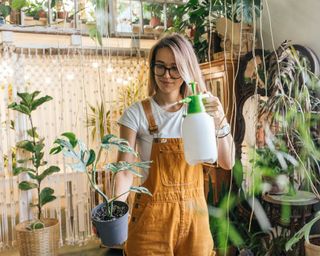
Misting plants is a simple way to increase the humidity
5. Cut back on fertilizer
You might think that fertilizing plants can give them a useful boost through the winter months, but for houseplants, it's best to hold off.
'With reduced growth during the darker months, fertilizer can actually cause a build-up of salts and minerals in your houseplants' soil,' says Jo. 'Pop it to the back of your cupboard to re-introduce in spring.'
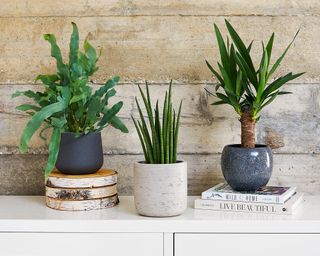
Plants don't need as much feeding over winter
How often should you water indoor plants over winter?
'A lot of houseplants go through a dormant period in winter – think of this a little bit like them going into hibernation and taking a well-earned rest after a summer of growing,' explains Jo.
'This means their growth will slow down in the cooler months and they won't need as much water,' she says. In fact, being over-enthusiastic with the watering is a common mistake that can lead them to rot – and that goes for the best winter plants for pots outdoors, too.
Only water them when the top two inches of soil feel dry to touch, Jo advises. 'And when you do hydrate, ditch the cold water as this could shock them – use room temperature water instead.'
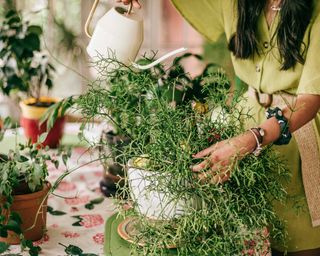
Most houseplants won't need much watering throughout the colder months
Which indoor plants need extra attention during winter?
The exception to the rule of cutting down on food and water is plants that are growing or flowering: generally African violets, orchids, indoor cyclamen, and any flowering indoor Christmas plant.
These will need periodic feeding and moisture, but always check the instructions as some, such as orchid and citrus plants, have specific feeds that are widely available online.

The garden was always a big part of Holly's life growing up, as was the surrounding New Forest where she lived. Her appreciation for the great outdoors has only grown since then. She's been an allotment keeper, a professional gardener, and a botanical illustrator – plants are her passion.
-
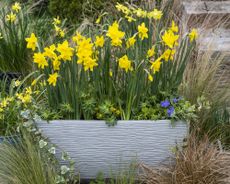 An Update on Gardeningetc
An Update on GardeningetcA word from our publisher
By Beth Murton Published
-
 Do you need to chit potatoes? Find out what the experts say
Do you need to chit potatoes? Find out what the experts sayGrow Your Own Learn how to chit potatoes before planting them in the ground and you’ll be on your way to getting an earlier and bigger harvest
By Drew Swainston Published
